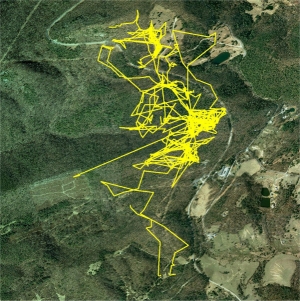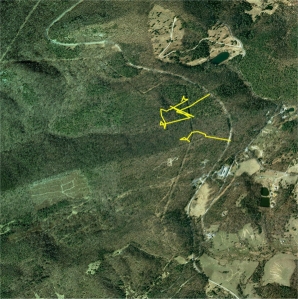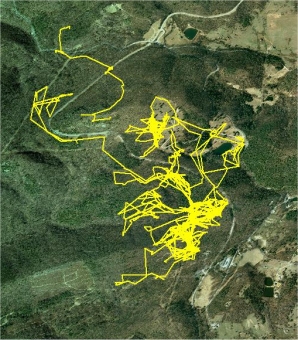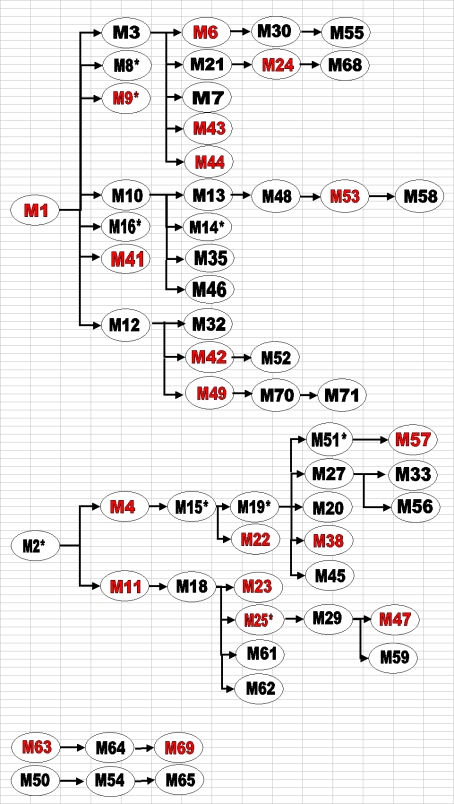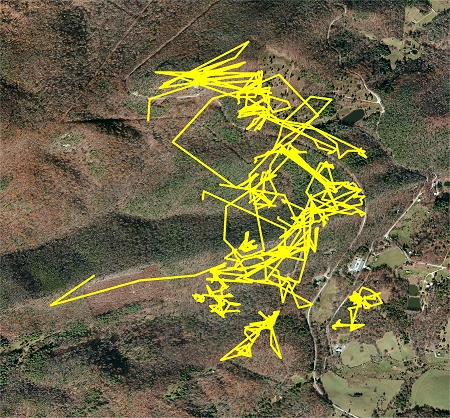This is a multi-year study and was it was designed to be that way from the start. Many too many studies seem to be of a single season or even less, studying few individuals, in small areas, and attempt to make conclusions based on this time-limited data. Following and studying the same turtle(s) for many seasons, emergence to hibernation, has given much more additional information than a single season ever would, and allows for a legitimate confirmation of previous research conclusions (or not).
Many college thesis, in particular, are so time limited to be of questionable value. And many contain so many cites ie. (Dodd, 1963), that the text is difficult to read and follow. The author may have proven he can research professional papers (Google, Proquest, and JSTOR), but much of the information is only regurgitated with little original research. Errors have a way of accumulating like a snowball rolling down a muddy hill.
Finding Turtles
Eastern Box turtles are not one large, mingling, continuous population from New England to Florida. There are hot spots where (relatively) large numbers of turtles are found, and areas where no Box turtles are found and have never been seen. Where found, these local populations, often distant from each other, are the same species, so can exchange DNA and change and evolve simultaneously as long as there is at least a minimum amount of movement between populations.
Nearly all Box turtles found in this study area were found while tracking previously radio-tagged turtles. Turtles M1 and M2 were found while crossing the highway in 2008, tagged and tracked into hibernation. Turtles M5, M26, M50, and M17 (transient) were also found crossing the road in subsequent years.
Most other turtles were found while searching for (tracking) M1, M2, M5 and subsequent finds. Searching the woods to find turtles, at least in this study area, is an impossible task. Turtle dogs (as well as undergrad students) have been used elsewhere, but covering this large of an area, at the very low turtle population density that exists here, may ultimately not be much better than allowing the turtles themselves to find their forest-mates.
Here is a chart showing the turtle-finding structure followed.
Processing
All processing is done in the field where the turtle is found. Turtles are not removed to another location, and are not permanently marked in any way.
Newly found turtles are weighed, measured, and photographed. A chart of this data is found elsewhere on this web site here. Detailed photos are taken of scutes for possible aging, and of any carapace or plastron damage or abnormalities. No permanent marking, such as filing or drilling is done.
The turtle location (as are all locations) is recorded. For the first 7 years, locations were marked with flagging which has the turtle ID, location number and date. Different color/pattern flagging was used for each year. (after year 7 this flagging activity was minimized)
If a transmitter is available, one is attached to the rear marginal scutes using 5-minute epoxy. If the turtle is to be thread-trailed, a bobbin carrier is epoxied onto a lower rear scute.
Philosophy and Methodology
Eastern Box turtles seek out each other (meet) for a number of reasons. Mating is an obvious reason, but there are many male/male and fewer female/female meetings that have been observed. It appears that there is communication of some sort going on during these meetings, but the actual purpose is unknown. All transient finds, so far, are a result of meetings between male members.
There are certainly chance encounters also, but few, if any, encounters are random. Low population density, long travel distances and very short sight distances would seem to necessitate some sort of learning and planning to keep members of the population in contact, or some way they can communicate their locations over distance. Meeting and Mating Page
Study Area Size The size of the study area has been largely determined by the turtles themselves. Except for turtles M17, M20, M31, M26 and M45, who are obviously transients, the turtles tracked have remained in the area shown, at least for now.
These photos represent annual turtle routes tracked
This large area aerial photo shows all Box turtle travel routes tracked from 2008 through 2023.
Eastern Box Turtle
Terrapene carolina carolina
A Relict Population Doomed To Extinction?
